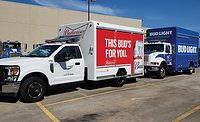Shortage of qualified CDL drivers poses industry challenges
Implementing additional trainers, equipment can help manage shortages

Training is tricky business, especially in an era where beverage distributors in virtually every U.S. city are dealing with a shortage of qualified CDL drivers. Finding them is hard enough. Keeping them is even harder. And when your operation invests in providing your delivery team with all of the world-class tools and techniques to keep them running on all cylinders, the last thing you want is to watch competing companies and industries poach your talent.
“This is an ever-increasing problem, especially in more urban areas where motor carriers have terminals or major companies may have distribution centers — such as Domino’s, Papa John’s, Panera, SysCo and other food suppliers,” says Steve Golladay, manager and owner of the supply chain logistics consultancy Total System Thinking Solutions. “Retention is becoming more difficult because you hire and then train a person for a CDL and they become a valued ‘commodity.’ Retention starts first with recruiting the right candidates, secondly by challenging the status quo of the job itself: ‘Are there ways to make the job more appealing and/or enabling expansion of the available labor pool?’”
Most won’t outspend the major commercial carriers, but you can create the “ideal” job for the drivers who like to be at home every night while still providing the best customer service and satisfaction based on the needs and requirements to get your beverage products to retailers and consumers, Golladay adds.
Trained driver poaching is an ongoing challenge for Houston-based Silver Eagle Distributors.
“Most companies in our market area who need CDL drivers know if they can tempt a Silver Eagle driver to jump ship, they are getting a highly qualified driver,” says Ed Pritchard, senior vice president of fleet management and purchasing at Silver Eagle. “Our training program has the reputation of producing good quality drivers. If CDL candidates make it through our training program, they become highly sought-after by other companies.”
When it’s purely a financial decision, Silver Eagle is often able to make an attractive counter-offer to keep the drivers on staff. “In other situations, drivers are leaving simply because they’re looking for something that isn’t quite as demanding from a physical aspect,” Pritchard continues. “It’s also worth noting that roughly 10 percent of the drivers who leave end up coming back when they realize that the grass wasn’t as green as they were led to believe.”
Pritchard’s team has hired additional trainers and purchased more equipment to help keep pace with driver turnover. The CDL driver shortage has created a huge backlog in available testing appointments at the local DMV, which prompted Silver Eagle to seek certification as Third-Party State Testers, by the Texas Department of Public Safety.
“This is a rather lengthy process where our driver trainers attend training alongside Texas state troopers in the state-defined process of administering the road test portion of the CDL testing process,” Pritchard explains. “This has allowed [Silver Eagle] to avoid the long lines at the DMV to secure CDL testing appoints. Of course, this process is laborious and does come with great responsibility, for which we are bonded and sworn to uphold the highest standards prior to awarding CDL status to a Silver Eagle CDL candidate.”
Silver Eagle requires its drivers to complete a detailed and in-depth training program, with a minimum numbers of hours set for the different phases of the process. The company’s goal is to get each student the maximum amount of one-on-one training possible in the behind-the-wheel phase of training, according to Pritchard.
When Silver Eagle CDL candidates are not training in a one-on-one environment with one of the distributor’s dedicated driver trainers (DDT), the company has incorporated three four-door training trucks — aka quad cabs — with a second-row seat allowing trainees to ride, observe and critique one another in a group training environment.
“This is a valuable tool which allows trainees to see how things work in a commercial motor vehicle from a different perspective,” Pritchard says.
After the initial training and licensing phase is complete, the trainee will then undergo training on a live route with a sales rep trainer to help them prepare to operate independently on a delivery route, he adds.
“A big part of training should be supervisor ride-alongs where the manager observes behaviors and gives timely and appropriate feedback to the employees,” Total System Thinking Solution’s Golladay advises. “Lots of companies now use computer-based training with periodic refresher sessions that include testing. However, the best is still observation and feedback.”
Silver Eagle’s Pritchard recommends that drivers should complete a refresher course at least once year. “No matter how good they are, drivers will develop bad habits and behaviors over time,” he says.
“Refresher training can bring these issues to the forefront,” he continues. “Drivers that continuously exhibit poor decision-making or otherwise bad driving behavior that can’t be corrected may require either more behind-the-wheel training or simply be removed from an active driving role.” BI
Looking for a reprint of this article?
From high-res PDFs to custom plaques, order your copy today!






